Llandyfaelog (formerly Llandefeilog) is a village which lies between the rivers Gwendraeth Fach and Towy, about three miles north-east of Ferryside, and four miles north of Kidwelly. The men of the village who fell during the Great War are presently commemorated on a war memorial inside Llandyfaelog Village Hall, although an amended memorial has recently been commissioned and erected inside St. Maelog’s Church. Just outside the Church is a memorial to the three Lowry brothers, Harry, Eric and Patrick, whose parents once lived for a short time in the area, and who on Sunday 21 December 1919 unveiled an eleven-foot-high cross and a leaded window to the memory of the young men, all officers. There is another memorial window in the Church to two nephews of the Lowry brothers who were killed during the Second World War, Stephen and James Francis.
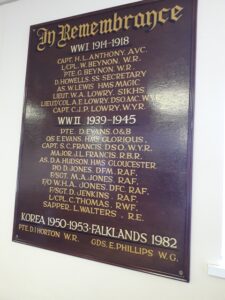
The Great War, 1914-1918
Henry Leonard Anthony, MID, Captain, Royal Army Veterinary Corps. Harry was the son of John and Elizabeth Anthony, of Cilveithy, Llandyfaelog. He had served in the South African campaign of 1901 to 1902, and after returning home served as Veterinary Surgeon to the Tredegar Iron and Coal Company. At the outbreak of the Great War Harry rejoined the Colours, serving with the Pembroke Yeomanry. Harry then served with the 1/1st Lancs Mobile Section, Army Veterinary Corps, which was attached to the 66th (2nd East Lancs) Division, arriving in France on 10 March 1916. By 1917 the Division was stationed around Arras, and took a leading role in the Battle of Arras, 1917. On 2 May 1917 Harry was killed by a bomb dropped by a German aeroplane. He was 40 years old, and was buried with full military honours at Faubourg D’Amiens Cemetery, Arras, France. Harry was one of six brothers who served during the Great War; two of his brothers, Jack and Ivor, had won the Grand National.
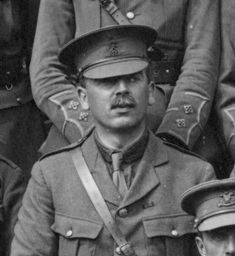
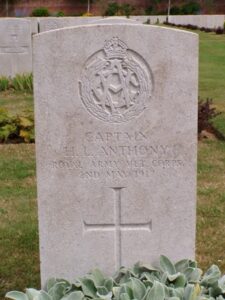
George Beynon, Corporal, 28522, Welsh Regiment. George was born in 1898, the son of Walter Beynon and Elizabeth Beynon, of Tyrefail, Llandyfaelog. He enlisted at Carmarthen into the Welsh Regiment, and after completing his training was posted to France, joining the 18th Battalion, Welsh Regiment, which was attached to 119 Brigade, 40th (Bantam) Division. The Division had moved to France in June 1916, and moved to the front near Loos. Late in 1916 they moved south to the Somme, and fought at the Battle of the Ancre, and remained in the area over the winter. In March 1917 the Germans withdrew to their shortened line, called the Hindenburg Line, and the 40th Division were one of the Divisions that followed the withdrawal. Later in the year they took part in the Battle of Cambrai, playing an important role in the attack on Bourlon Wood. They remained in the area over the coming months, but were caught here by the German Spring Offensive of 21 March 1918, and fought there at the Battle of St Quentin. Due to the terrible casualties suffered by the Division here they were sent north to Flanders to rest and rebuild, but in April the Germans launched an offensive in Flanders, and the 40th Division were caught up in the thick of it again. George was killed during a day of horrific fighting on 13 April 1918. The 20-year-old has no known grave so is commemorated on the Ploegsteert Memorial, Belgium. His half-brother William had been killed in Mesopotamia in 1917.
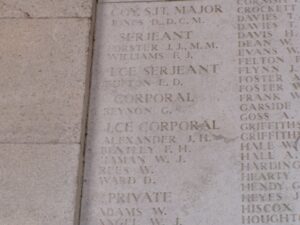
William Richard Beynon, Private, 12972, South Wales Borderers. William was born in Llandyfaelog on 15 May 1888, the son of Walter Beynon and Jane Beynon (nee Jenkins). William worked as a collier prior to the war and after marrying Mary Jane George at Pontyberem on 14 May 1911, the couple set up home together at Pantyfer. William then found work as a haulier for the Co-Operative Stores at Pontyberem. He enlisted at Tumble soon after the outbreak of war and was posted to the 4th Battalion, South Wales Borderers, which was attached to the 40th Brigade, 13th (Western) Division. On 13 June 1915 the Division sailed for the Mediterranean, and during July 1915 landed on Cape Helles, relieving the 29th Division, before moving to ANZAC Cove from 3 August 1915, taking part in the Battles of Sari Bair, Russell’s Top, and Hill 60, ANZAC. Soon afterwards the Division was transferred from ANZAC to Suvla Bay, and it was evacuated from Suvla on 19 December 1915, transferring to Helles. On 8 January 1916, the Division was evacuated from Helles, and by 31 January was concentrated at Port Said, where they held forward posts in the Suez Canal defences. On 12 February 1916 the Division began to move to Mesopotamia, to strengthen the force being assembled for the relief of the besieged garrison at Kut al Amara, but the relief failed, and Kut fell to the Turks. The Division then took part in the advance through Mesopotamia, which was to successfully liberate the country from centuries of Ottoman rule. By January 1917 the 13th Division had taken up positions facing the Hai Salient, and began to press attacks. On 15 February Welshmen of 40 Brigade, 8th RWF and 4th SWB, broke the centre of the enemy position and were followed up by troops of the 13th and 14th Divisions who completed the rout. Two days later General Cobbe launched an attack on the Sannaiyat positions, but the Turks held out until nightfall on 23 February following a surprise river crossing by the Norfolk’s and Ghurkhas which forced the Turks to withdraw again. By 25 February the Turks were in full retreat, pursued by the 13th and 14th Divisions and the Cavalry and halted at Azizaya, midway between Kut and Baghdad, while the British supply lines were adjusted. William was killed in action here on 25 February 1917. The 29-year-old has no known grave, so is commemorated on the Basra Memorial, in Iraq. William is also commemorated on the Pontyberem War Memorial. His half-brother George, was killed in France the following year.
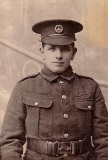
Sydney Ernest Branfield, Private, 320111, Welsh Regiment. Sydney was born in 1885, the son of Edward and Emily Branfield of Tynewydd, Llangunnor. The family moved to Cwmffrwd Cottage, Llandyfaelog prior to 1901. Sydney enlisted at Carmarthen into the Pembroke Yeomanry, which moved to Egypt in March 1916 as part of the 1st Mounted Division. In March 1917 the battalion merged with the Glamorgan Yeomanry to form the 24th Battalion, Welsh Regiment, which was attached to 231 Brigade, 74th (Yeomanry) Division. The Division then took part in the advance into Palestine, and it was during this advance, at the Third Battle of Gaza, that Sydney was killed on 30 October 1917. He was 32 years old, and is commemorated on the Jerusalem Memorial, Israel. Sydney is not commemorated on the Llandyfaelog Memorial.
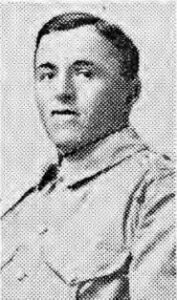
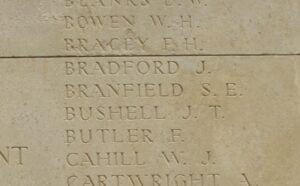
William Stanley Davies, Private, 25166, West Riding Regiment. William was born at Cwmffrwd, the son of David and Elizabeth Davies. The family later resided at 57, Hillfield, Station Road, Kidwelly. He enlisted at Llanelli into the Army Service Corps, but later transferred into the 10th Battalion, West Riding Regiment, which was attached to 69 Brigade, 23rd Division. In August 1915 the Division moved to the Western Front, initially concentrating near Tilques. They saw their first major action at the Battle of Albert, where they captured Contalmaison, and then fought at the Battle of Bazentin, the Battle of Pozieres, the Battle of Flers-Courcelette, the Battle of Morval and the Battle of Le Transloy, where they captured Le Sars. In May 1917 they took part in the Battle of Messines, before moving further north to Ypres, and fighting at the Battle of the Menin Road, where William was wounded. He was transported back to the Casualty Clearing Station at Remy Sidings where he died of wounds on 25 September 1917. He was 24 years old, and is buried at Lijssenthoek Military Cemetery, Belgium. William is not commemorated on the Llandyfaelog Memorial.
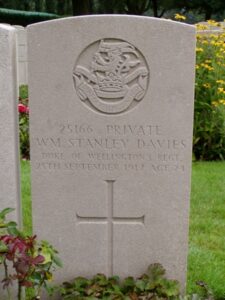
David John Howells, Private, 202759, Welsh Regiment. David was born at Danyrallt, Llandyfaelog, the son of Philip Howells and Eleanor Howells (nee Anthony). The family later resided at Maes Gwenllian, Kidwelly. He was a Carpenter and Wheelwright prior to enlisting into the 4th Battalion, Welsh Regiment soon after the outbreak of war. David was sent to France in 1917 to join the 18th Battalion, Welsh Regiment, who were attached to 119 Brigade, 40th (Bantam) Division. Later in 1917 the Division took part in the Battle of Cambrai, playing an important role in the attack on Bourlon Wood. They remained in the area over the coming months, but were caught here by the German Spring Offensive of 21 March 1918, and fought a stubborn defence over the coming days. Due to the terrible casualties suffered by the Division here they were sent north to Flanders to rest and rebuild, but in April the Germans launched an offensive in Flanders, and the 40th Division were caught up in the thick of it again, fighting at the Battle of Estaires, and then at the Battle of Hazebrouck. Following losses in the defence of Hazebrouck, the Division was reduced to a training cadre. A major reorganisation took place, with battalions that had been Garrison Guard units joining and being converted to fighting units. The Division was ready for front-line action again by 18 July 1918, when they took part in the Advance in Flanders, and the Battle of Ypres, 1918. David was taken ill during the final months of the war, and was brought to the Base Hospital near Boulogne, where he died on 31 December 1918, aged 32. He is buried at Terlincthun British Cemetery, Wimille. David is not commemorated on the Llandyfaelog Memorial, although it lists a D. Howells, of the S.S. Secretary. The 1922 published Carmarthen County War Memorial states that D. J. Howells, Welsh Regiment, was the Llandyfaelog man and my research tends to support this.
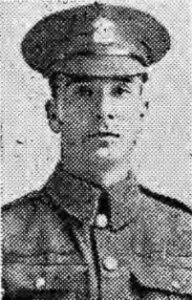
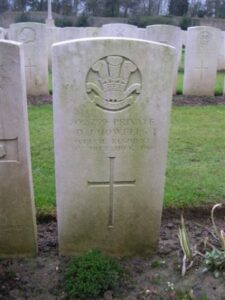
David Bowen Jones, Private, 51307, Royal Scots Fusiliers. David was born on 16 February 1889, the son of John Conwil Jones and Maria Jones, of Tycanol, Llandyfaelog. He was educated at Idole School, before training as a Tailor. David married Margaret Ann Evans, of 52, Glenalla Road, Llanelli on 10 May 1915, and fathered a son, Raymond, before enlisting into the army at Llanelli on 17 April 1916. He was posted to the 3rd Battalion, Royal Scots Fusiliers, and embarked aboard the Troopship Aragon in December 1917, which was bound for Egypt. David was drowned when Aragon was torpedoed in the Mediterranean on 30 December 1917. He was 28 years old, and is commemorated on the Alexandria Chatby Memorial, Egypt. His son Raymond had just been born on 9 November 1915. David is not commemorated on the Llandyfaelog Memorial.
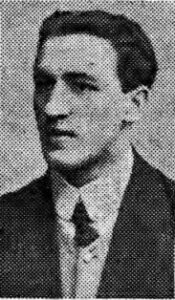
John Jones, Private, 368134, Royal Army Medical Corps. John was the son of Richard and Mary Jones, of Cwmffrwd Uchaf, Cwmffrwd. He enlisted at Swansea into the 3rd Welsh Field Ambulance, Royal Army Medical Corps, which was attached to the 53rd (Welsh) Division. The Division landed at Gallipoli on 8 August 1915, serving there until the evacuation of the peninsula. It then took part in the Egyptian and Palestinian campaigns. John must have taken ill in Palestine, and was brought back to England for treatment at the Richmond Military Hospital. He died of disease there as a result of his overseas service on 14 February 1918. The remains of the 22-year-old were brought home and he was buried at Merthyr (Cana) Congregational Chapelyard, near Bancyfelin. John is not commemorated on the Llandyfaelog Memorial.
William Anthony Jones, Private, 56883, Royal Welsh Fusiliers. William was the son of David and Jane Jones, of The Black Lion Inn, Cwmffrwd. He was educated at Carmarthen Grammar School and had become a member of the local Red Cross and was a reporter for the Carmarthen Journal prior to enlisting in London into the Welsh Regiment. He later transferred into the 14th Battalion, Royal Welsh Fusiliers, who were attached to the 113th Brigade, 38th (Welsh) Division. The Division had landed in France during December 1915 and had spent their first winter in the trenches near Armentieres. In June they marched south to the Somme, where they were tasked with the capture of Mametz Wood. The attack on the wood began on 7 July, but met with fierce resistance, and it took until 14 July to clear the wood. The Division suffered terrible casualties at Mametz, and were taken out of the line, and moved to Ypres to rebuild. William was among a large number of reinforcements who joined the battalion here and soon settled into the monotonous life of trench warfare. On 1 October 1916 his battalion was in the front line along the canal bank working on laying duck boards in the sodden trenches towards a trench named Huddersfield Road. A fighting patrol of ten men under Lieutenant Seymour was sent out while this work was underway and encountered a German patrol. After an exchange of fire, in which the Germans suffered several casualties, the raiding party withdrew. The Germans in retaliation then fired over a Trench Mortar barrage onto the Fusiliers which caused several casualties among the battalion. William had been killed instantaneously during the bombardment and his remains being buried in Essex Farm Cemetery, the burial service being taken by the Chaplain Reverend Williams. He was 22 years old. William is not commemorated on the Llandyfaelog Memorial.
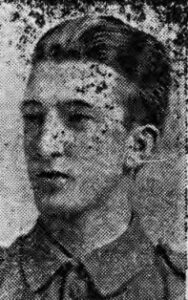
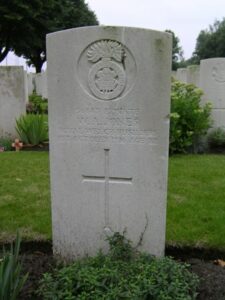
William Lewis, Able Seaman, J/42916, Royal Navy. William was born on 8 August 1896, the son of John and Margaret Lewis, of Panthowell, Kidwelly. He enlisted into the Royal Navy on 8 August 1915 and was posted to HMS Vivid I for training. William married Catherine Elizabeth Anthony, of Nantgaredig House, Four Roads whilst home on leave in 1916 and their only child, a son, William, was born on 26 April 1916. Upon his return to the Royal Navy following his leave, William was posted aboard the destroyer HMS Magic, which was part of the Eleventh Destroyer Flotilla. Magic had served at the Battle of Jutland, which had been fought on 31 May 1916, and had launched a torpedo attack against the German High Seas Fleet. On 10 April 1918, Magic was on patrol off the Irish coast near to Lough Swilly when she struck a mine which had been laid by the German submarine SM UC-31. William was among 25 men killed in the resulting explosion. The 21-year-old has no known grave and is commemorated on the Plymouth Naval Memorial, Devon. Magic did not sink, but was successfully repaired and returned to service. William is also commemorated on his parents grave at Llandyfaelog.
Auriol Ernest Eric Lowry, DSO, MC, Lieutenant Colonel, West Yorkshire Regiment. Auriol was born on 4 December 1892, the second son of William Buchanan Lowry and Annie Sophia Lowry, Manor Way Grange, Lee-on-Solent. He was educated at St. Andrew’s, Southborough and at Cheltenham College before going to Sandhurst and was commissioned into the West Yorkshire Regiment on 5 February 1913. He was serving in Malta as a Lieutenant with the 2nd Battalion, West Yorks by the outbreak of war and disembarked in France with the battalion on 5 November 1914. Auriol was obviously a brave man and a good officer, as by the end of 1917 he had become promoted to command his battalion, becoming one of the youngest men to do so during the war, and had also been awarded the Distinguished Service Order, Military Cross and Croix de Guerre avec Palme, as well as having been mentioned in despatches three times. On 23 September 1918 the battalion, which had been attached to 23 Brigade, 8th Division for the entire war, was taking part in the great advance and had reached the Acheville Sector, near Arleux-en-Gohelle. Auriol had despatched two companies of his battalion to hold posts in the front line, with a third in support and one in reserve and was making his way forward to visit the posts when he was hit by German machine-gun fire and killed. He was 25 years old and was carried back behind the lines to be buried in La Targette British Cemetery, Neuville-St. Vaast. His brothers Cyril and William also fell.
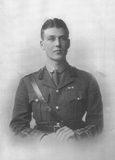
Cyril John Patrick Lowry, Captain, West Yorkshire Regiment. Cyril was born in Pembrokeshire in 1898, the youngest son of William Buchanan Lowry and Annie Sophia Lowry, Manor Way Grange, Lee-on-Solent. He was commissioned into his brothers unit, the West Yorkshire Regiment in September 1915 and joined the 2nd Battalion, West Yorks in France during September 1916. By the end of 1917 Cyril had been promoted Captain and was serving under his brother Auriol. By 12 March 1918 the battalion had moved to a rest camp behind the lines at Wizernes, where the men drilled and carried out various training routines. On 21 March the Germans launched a massive offensive, Operation Michael, against the British front facing the Hindenburg Line near St. Quentin and advancing through thick fog, behind a wall of artillery fire, smashed a hole in the British lines. After being put on four hours notice to move later that day the 2nd Battalion, West Yorks was among a large number of reserve battalions sent forwards to attempt to stem the German advance and on the following day entrained for Chaulnes before marching onto Villers Carbonnel. During the early hours of 23 March the battalion moved forwards to cover the retirement of the 50th Division and took up positions along a bridgehead at Eterpigny where it came under heavy shellfire and was relieved during the night. The Germans attacked and crossed the bridge on 25 March and the 2nd West Yorks received orders to counter-attack and regain the position. Heavy fighting raged during the day and many men were lost. Among the dead was Cyril, who was just 20 years old. His body was never found and he is commemorated on the Pozières Memorial. His brothers, Auriol and William, also fell.
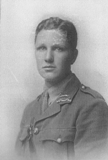
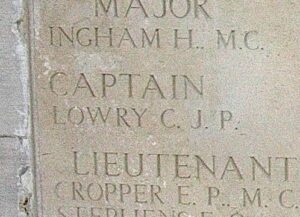
William Augustine Harper Lowry, MiD, Second Lieutenant, Indian Army. William was born in Calcutta on 21 February 1890, the eldest son of William Buchanan Lowry and Annie Sophia Lowry. His father was a wealthy tea merchant and soon after the birth of his first son retired and moved the family to Manor Way Grange, Lee-on-Solent. William was educated at St Andrew’s Tonbridge and at Cheltenham College before being admitted to Caius College, Cambridge where he studied French, Physics and Chemistry. He left England in 1910 and sailed for Calcutta to become a tea planter at Manikande Parakadua in Ceylon. Whilst there he joined the local Militia, the Ceylon Planters Rifle Corps and sailed for Egypt with the battalion on 17 November 1914. The battalion disembarked at Port Said and went into barracks at Abbassia and in December marched to Zeitoun. Sixty men of the battalion, including William, were chosen to be commissioned into the Indian Army, and William was posted to the 14th King George’s Own Ferozepore Sikhs, which were attached to 51 Brigade, 17th (Indian) Division. On 4 June 1915 the division launched an attack against the Turkish line at the head of Gully Ravine, supported by fire from battleships anchored off-shore. The gulley was steep and strongly wired and the Indians were mown down by the Turks from their dominant defensive positions. During their assault the 14th Sikhs lost twelve British officers, eleven Indian officers and 380 men killed or wounded and the few survivors were forced to withdraw. William was among the dead. He has no known grave and is commemorated on the Helles Memorial, Gallipoli. His brothers Auriol and Cyril were killed later in the war.
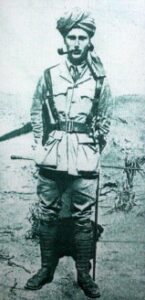
John Rees Morgan, Private, 2118, Welsh Guards. John was born at Llandyfaelog, the son of David and Rachel Morgan. John emigrated to America at some time, and his parents moved to Rhydywalchen, Peniel Road, Carmarthen. John came home from America to enlist at Carmarthen into the 1st Battalion, Welsh Guards, which had formed on 26 February 1915. The Welsh Guards moved to France on 18 August 1915 attached to 3rd Guards Brigade, Guards Division, and moved to Loos. The Welsh Guards had their baptism of fire at Loos, and in the summer of 1916 moved to the Somme sector. John was killed on the Somme on 10 December 1916, when the Welsh Guards were under heavy German artillery fire. John has no known grave, and is commemorated on the Thiepval Memorial, France. John was 29 years old. John is not commemorated on the Llandyfaelog Memorial.
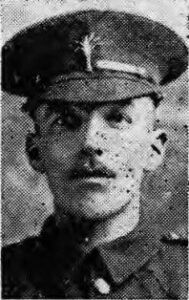
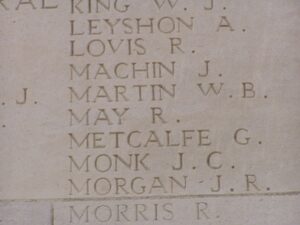
David Tom Thomas, Private, 204732, Royal Welsh Fusiliers. David, known as Tom, was born at Llanfihangel ar Arth in 1897, the son of Samuel and Mary Hannah Thomas (nee Hughes). His father was from Llandyfaelog, and his mother from Llanfihangel and by 1901 the family was living in Idole Villa, Llandyfaelog, where Samuel had gained work as a coachman. By 1911 the family had moved to Llaingotten, Cwmffrwd, and Tom was working as an apprentice draper at Albion House, Carmarthen. Tom enlisted into the Welsh Regiment at Carmarthen on 22 February 1916 and was posted to the 20th Battalion, Welsh Regiment at Kinmel Park. On 27 May he was transferred to the 2/5th Battalion, Royal Welsh Fusiliers, which was at Bedford, attached to the 68th (2nd Welsh) Division. Tom began to suffer with his health soon afterwards and was eventually found to be suffering from tuberculosis, so was discharged from the army as medically unfit on 17 September 1917. He was sent to a sanatorium for treatment, but his health continued to deteriorate and Tom died of tuberculosis at home on 17 February 1918. The 21-year-old was buried in St. Anne’s Churchyard, Cwmffrwd. Tom is not commemorated as a casualty of the war by the CWGC, as his illness was deemed as being contracted before his enlistment.
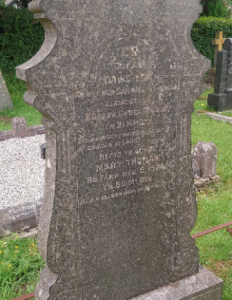
—————————————————————————————————————————–
World War Two, 1939-1945
David Daniel Evans, Private, 5392452, Oxford and Bucks Light Infantry. David was born on 9 November 1913, the son of Ivor and Ada Evans, of Gellydeg Lodge, Llandyfaelog. He worked as a gardener and handyman at Fifteen Ways, Penn, near Wycombe, Buckinghamshire prior to the war. David enlisted into the army and was posted to the 7th Battalion, Oxfordshire and Buckinghamshire Light Infantry, which was attached to the 167th Infantry Brigade. The Battalion fought throughout the campaign in the Western Desert and entered Tunis on 7 May 1943 after the successful Battles of El Alamein had virtually wiped out the German Afrika Korps. David was killed in action soon afterwards, on 9 May 1943, aged 29. He is buried in Enfidaville War Cemetery, Tunisia.
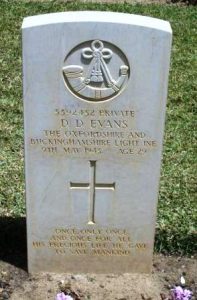
William Elwyn Evans, Ordinary Seaman, D/JX 152289, Royal Navy. William was born on 17 October 1921, the son of William Evans and Rachel Anne Evans (nee Rowlands), of Llandyfaelog. He served with the Royal Navy, aboard the aircraft carrier HMS Glorious. Glorious had started life as a Battlecruiser, but had been converted to an aircraft carrier during the 1920’s. After the start of the Second World War, Glorious spent the rest of 1939 hunting for the German cruiser Admiral Graf Spee in the Indian Ocean before returning to the Mediterranean. She was recalled to home waters in 1940 to support British operations in Norway. On 8 June 1940 Glorious was leaving Norway to ferry aircraft back to Britain when she was attacked and sunk by the German battleships Scharnhorst and Gneisenau in the North Sea with the loss of over 1,200 lives. William was 18 years old when he died that day, and is commemorated on the Plymouth Naval Memorial, Devon.
Stephen Charles Francis, DSO, Captain, 73119, West Yorkshire Regiment (Prince of Wales’s Own). Stephen was born in Essex on 24 July 1917, the son of Brigadier-General Sidney Goodall Francis, DSO, and Catherine Gwendoline Francis (nee Lowry), the sister of the three Lowry brothers who fell during the Great War. He was educated at Sherbourne School and at Sandhurst prior to being commissioned into the West Yorkshire Regiment and was posted to India with their 1st Battalion. The battalion was moved to Rangoon before taking part in the terrible fighting which followed the Japanese invasion of Burma. Stephen was killed on 8 March 1942, aged 24. He has no known grave and is commemorated on the Rangoon Memorial, Myanmar. He had been awarded the DSO and been Mentioned in Despatches twice during his time at war. His brother, James Lowry Francis, also died on service.
James Lowry Francis, Major, 95637, Royal Berkshire Regiment. James was born in York on 13 June 1921, the son of Brigadier-General Sidney Goodall Francis, DSO, and Catherine Gwendoline Francis (nee Lowry), the sister of the three Lowry brothers who fell during the Great War. He was educated at Sherbourne School before attending Sandhurst and passed out in July 1939. He was posted to the 1st Battalion, Royal Berkshire Regiment. In November 1944 he was posted to Burma with the 2nd Battalion, Royal Berkshire Regiment. He took part in the crossing of the Chindwin River and was killed in action during a reconnaissance on 21 January 1945, aged 24. James is buried in Taukkyan War Cemetery, Myanmar. His brother, Stephen Charles Francis, also died on service.
David Andrew Hudson, Able Seaman, D/JX 154807, Royal Navy. David was born on 6 February 1922, the son of Thomas and Mary Ann Hudson, of Croesyceiliog Fawr, Llandyfaelog. He served in the Royal Navy aboard the Town Class cruiser HMS Gloucester. At the outbreak of war, Gloucester was the flagship of the 4th Cruiser Squadron, serving in the East Indies and spent the rest of that year patrolling the Indian Ocean. In December, she was moved to Simonstown, South Africa where she was used, unsuccessfully, against German raiders. She was transferred again in May 1940, this time to the Mediterranean, where she experienced plenty of action. She was involved in Malta convoys and the Battle of Calabria on 9 July 1940. An Italian air attack on 8 July had hit the ship’s bridge killing or wounding most of the bridge personnel, including the Captain. The second half of 1940 was spent in the eastern Mediterranean and in the Aegean. On 11 January 1941, while supporting Operation Excess, Gloucester was hit by a bomb which failed to explode. In March, she was at the Battle of Matapan and, in April, performed several bombardments along the north African coast. A second bomb hit caused minor damage. Gloucester formed part of a naval force acting against German military transports to Crete, with some success. On 22 May 1941, while in the Kithera Channel, about 14 miles north of Crete, she was attacked by German Stuka dive bombers and sank, having sustained at least four heavy bomb hits and three near-misses. David was among 723 men killed in the sinking of Gloucester that day, with just 82 survivors. Her sinking is considered to be one of Britain’s worst wartime naval disasters. David was just 18 years old and is commemorated on the Plymouth Naval Memorial, Devon.
Daniel Evan Jenkins, Sergeant (Air Gunner), 1420304, Royal Air Force Volunteer Reserve. Daniel was the son of John Jenkins and Mary Jane Jenkins (nee Jones), of Cilcennin, Ceredigion. His mother had been born and raised at Tainewydd, Llandyfaelog. Daniel served as an Air Gunner with 70 Squadron, Royal Air Force, which was after the outbreak of war was based in the Middle East, flying the Vickers Wellington. Daniel was an air gunner aboard Wellington LN918, which crashed with the loss of all her crew some five miles west of San Severo, Italy on 25 February 1944. He was 20 years old, and is buried at Bari War Cemetery, Italy alongside his fellow aircrew. He was a cousin to David John Jones, below.
David John Jones, DFM, Pilot Officer, 129218, Royal Air Force Volunteer Reserve. David was born in 1920, the son of James Jones and Ellen Gwen Jones (nee Harries), of Bryn Llawddgar, Pontyates. His mother was from Llandyfaelog. After being educated at Carmarthen Grammar School, David enlisted into the Royal Air Force Volunteer Reserve, training as a Wireless Operator/ Air Gunner, before being posted to 12 Squadron, Royal Air Force, which was equipped with the Vickers Wellington III. On the evening of 28 August 1942, David took off from RAF Binbrook, aboard Vickers Wellington Z8656, which was part of a large formation sent to bomb strategic targets around Cassel, France. He was killed when his Wellington was shot down over Germany that night, 28 August 1942, with the loss of all her crew of five, three of whom were Welshmen. The 22-year-old is buried in Reichswald Forest War Cemetery, Germany. David was the holder of the Distinguished Flying Medal. He was a cousin to Daniel Evan Jenkins, who was also killed.
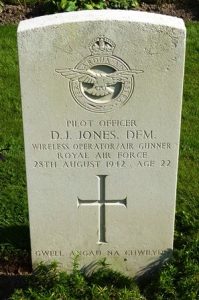
Mervyn Anthony Jones, Flight Sergeant, 748630, Royal Air Force Volunteer Reserve. Mervyn was born at Llwynwhilwg Farm, Llanelli on 12 May 1919, the son of Herbert Jones and Anne Elisabeth Jones (nee Anthony). The family later owned Cillefwr Farm, Carmarthen and Mervyn was educated at Queen Elizabeth’s Grammar School, Carmarthen. Mervyn was a well-known jockey prior to the war and had won the Grand National Steeplechase in 1940, riding Bogskar, not long after having enlisted into the Royal Air Force along with his brother William. Both men qualified as Pilots, and Mervyn was posted to No. 1 Photographic Reconnaissance Unit, Royal Air Force, which was equipped with the Supermarine Spitfire. Mervyn was posted missing after a North Sea sortie on 3 April 1942, when his Spitfire, Serial AA797, was intercepted and shot down into the Fjord between Frosta and Tømmerdalen in Leksvik. Mervyn parachuted, but drowned before a German rescue launch could save him. The 22-year-old has no known grave, and is commemorated on the Runnymede Memorial, Surrey. His brother William was killed just over two years later. Both brothers medals were sold at Dix Noonan Webb on 6 July 2004. A fellow Spitfire from the same unit, Spitfire, AA810, has recently been discovered and recovered from the same Fjord and is in the process of being restored.
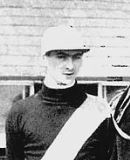
William Hywel Anthony Jones, DFC, Flying Officer, 139316, Royal Air Force Volunteer Reserve. William was born at Llwynwhilwg Farm, Llanelli on 25 December 1915, the son of Herbert Jones and Anne Elisabeth Jones (nee Anthony). The family later owned Cillefwr Farm, Carmarthen and William and his brother Mervyn were educated at Carmarthen Grammar School. William was a well known jockey like his brother Mervyn, and rode against him in the 1940 Grand National, falling from his horse ‘National Night’. William had enlisted into the Royal Air Force Volunteer Reserve with Mervyn, and qualified as a Pilot, joining 517 Squadron, Royal Air Force, which was a Coastal Command unit, equipped with the Handley Page Halifax V, based at RAF Brawdy. During the war, William made several daring attacks against German U-Boats. He was awarded the Distinguished Flying Cross, and was also Mentioned in Despatches for his gallantry during the war. The recommendation for his DFC, published in the London Gazette of 20 August 1943, read; ‘Pilot Officer Jones has maintained a very high standard in his work throughout his operational career. He made four attacks on U-Boats, inflicting damage on three occasions. He has also made a very determined attack on a blockade runner. Recently he was captain of an aircraft which successfully fought off attacks by seven Ju. 88s over a period of 45 minutes. The safe return of the aircraft was largely due to this officer’s fine tactics and superb airmanship.’ His Mention in despatches was listed in the London Gazette of 1 January 1943. William was posted missing during his second tour of operations on 14 November 1944 when his Wellington was forced to ditch off Lundy Island, in the Bristol Channel, when unable to land due to bad weather conditions, after returning from a Meteorological Recce Sortie. The 29-year-old has no known grave and is commemorated on the Runnymede Memorial, Surrey. His medals were sold along with Mervyn’s in a Dix Noonan Webb Auction on 6 July 2004.
Daniel David Clifford Thomas, Fusilier, 4204908, Royal Welch Fusiliers. Daniel, known as Clifford, was born in 1920, the son of Jonny Thomas and Rachel Thomas (nee Bowen), of Waunllanau-Uchaf, Newchurch. He enlisted into the army and was posted to the 6th Battalion, Royal Welch Fusiliers, which was attached to the 158th Brigade, 53rd (Welsh) Division. The Division was mobilised at the outbreak of war, moving to Northern Ireland to begin garrison duties. The Division then moved again to Pembroke Dock, before moving again to the south of England, where it trained in readiness for the D-Day Landings. During the last week of June 1944 the various units of the Division left England for Normandy, and landed at La Riviere near Ver Sur Mer, taking part in heavy fighting over the coming weeks, as part of the effort to break-out of the Normandy beach-head, seeing heavy fighting at Évrecy as part of Operation Greenline. The 158th Infantry Brigade came under temporary command of the 15th (Scottish) Division for the operation and on the night of 16/17 July went into action, ordered to take Évrecy. As the men descended the hill into the valley of the River Guighe the enemy released a quantity of smoke which rolled across the battlefield, slowing up the pace of advance, but by 02.00 the advance parties of the Brigade had crossed the Guighe and were advancing up the slope towards the Ferme de Mondeville, but came under heavy fire and suffered heavily before being ordered to withdraw. Daniel was killed in action during the attack that day, on 17 July 1944. The 24-year-old was originally buried in an isolated grave in Baron, but in November 1945 his grave was exhumed and he was re-interred in Hottot-Les-Baggues War Cemetery, France.
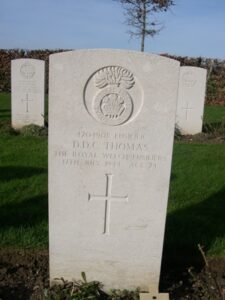
Leslie Walters, Sapper, 1905896, Royal Engineers. Leslie was born on 1 April 1918, the son of William and Elizabeth Walters (nee Pearce), of The Old Vicarage, Llandyfaelog. He worked as a carpenter prior to the war. Leslie enlisted into the Royal Engineers soon after the outbreak of war, and married his wife, Pat, at some time afterwards. He served with the 11th Field Company, Royal Engineers, which formed part of the invasion force that landed at Normandy during June 1944. Leslie was killed during the advance through Holland on 19 September 1944. The 26-year-old is buried in Bergen-Op-Zoom War Cemetery, Netherlands.
—————————————————————————————————————————–
Korean War, 1950-1953
David Ieuan Horton, Private, 22398204, Royal Welch Fusiliers. David was born on 24 February 1932, the son of Thomas Daniel Horton and Gertrude Horton (nee Morgans), of Llandyfaelog. He served with the Royal Welch Fusiliers, and was one of just over 100 Fusiliers who were sent to Korea as reinforcements for the Welch Regiment following the opening of the Korean War. David was killed in Korea on 15 June 1952, aged 20 and is buried in the United Nations Memorial Cemetery, Pusan.
—————————————————————————————————————————–
Falklands War, 1982
Eirwyn John Phillips, Guardsman, Welsh Guards. Eirwyn was born on 4 June 1962, the son of William Gwynfor Phillips and Phoebe Violet Phillips (nee Lewis), of Pantyrhodyn, Cwmffrwd. He served with the 1st Battalion Welsh Guards. Eirwyn was aboard the Troopship RFA Sir Galahad when it was attacked by A4-C Skyhawks of the Argentinian Air Force on 8 June 1982 and was hit by three bombs. The resulting explosions and fire killed 48 men, mostly of the Welsh Guards, but also men of other units. Eirwyn was 20 years old when he was killed that day. Sir Galahad was later towed out to sea and scuttled, becoming a war grave. Eirwyn is commemorated on the Armed Forces Memorial at Alrewas, Staffordshire.
—————————————————————————————————————————–
Afghanistan War, 2001-2014
Nigel Dean Mead, Marine, Royal Marines. Nigel was born at Carmarthen, the son of Philip and Amanda Mead, and was educated at Queen Elizabeth School. He joined the Royal Marines in October 2008. He was sent to Afghanistan with 42 Commando, Royal Marines, on his first tour of duty. Nigel was searching a compound in Helmand province when he was killed by an improvised explosive device on 15 May 2011. He was just 19 years old.